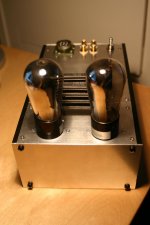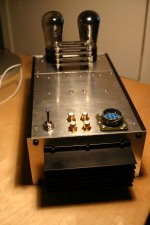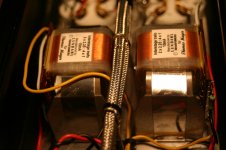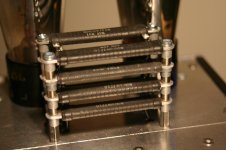...other candidates would be the Hashimoto 20K part.
I suggest their 10K version, the HL-10K-6.
One thing about all of the Hashies that I've tried (and measured) is that they like to be driven from a source impedance very close to their rated impedance. In this case, the 7-8K from the 26 should match pretty well with the 10K primary. If you were to use the HL-20k-6, you'd likely experience a good deal of treble peaking.
But, as always, YMMV.
JL
Here you go.
* type26cun LTSpice model
.subckt type26cun P G K
CGK G K 3.5p
CPK P K 2.2p
CGP G P 8.1p
* koren 4
Bp P K I=(0.0169871083m)*uramp(V(P,K)*ln(1.0+exp((12.39904937)+(12.39904937)*(8.189852358)*V(G,K)/V(P,K)))/(12.39904937))**(1.40553086)
* koren 8
* Bp P K I=(0.01505035691m)*uramp(V(P,K)*ln(1.0+(0.04617378061)+exp((13.71786498)+(13.71786498)*((8.563661196)+(9.663362929m)*V(G,K))*V(G,K)/sqrt((-1.856325497e-005)**2+(V(P,K)-(-5.468070728))**2)))/(13.71786498))**(1.432783777)
.ends type26cun
* type26cun LTSpice model
.subckt type26cun P G K
CGK G K 3.5p
CPK P K 2.2p
CGP G P 8.1p
* koren 4
Bp P K I=(0.0169871083m)*uramp(V(P,K)*ln(1.0+exp((12.39904937)+(12.39904937)*(8.189852358)*V(G,K)/V(P,K)))/(12.39904937))**(1.40553086)
* koren 8
* Bp P K I=(0.01505035691m)*uramp(V(P,K)*ln(1.0+(0.04617378061)+exp((13.71786498)+(13.71786498)*((8.563661196)+(9.663362929m)*V(G,K))*V(G,K)/sqrt((-1.856325497e-005)**2+(V(P,K)-(-5.468070728))**2)))/(13.71786498))**(1.432783777)
.ends type26cun
Hello,
Today I finished the 26 pre-amp, albeit still need to build the power supplies.
I did a listening test and was very surprised with the results. Great sound, very warm and natural and gave me the additional slight gain I needed.
I tried a pair of Sylvania 26, which could notice a bit of hum induced when I put my hand around the tube! Then switched to a pair of CX-326. Much better mid and treble.
Noticed that when HT was off had a distinct hum noise which is gone when I apply the HT. Any ideas why this could be?
I have the output floating to the amp i.e. the LL1660 secondary is not grounded...
Thanks
Ale
Today I finished the 26 pre-amp, albeit still need to build the power supplies.
I did a listening test and was very surprised with the results. Great sound, very warm and natural and gave me the additional slight gain I needed.
I tried a pair of Sylvania 26, which could notice a bit of hum induced when I put my hand around the tube! Then switched to a pair of CX-326. Much better mid and treble.
Noticed that when HT was off had a distinct hum noise which is gone when I apply the HT. Any ideas why this could be?
I have the output floating to the amp i.e. the LL1660 secondary is not grounded...
Thanks
Ale
Attachments
Well, that looks great! And the (expandable) pictures are great also. Thanks for sharing.
Hum after switching off your HT is a strange phenomenon. Is this happening when filament supply is still on? Looks like the only source then.
Are there two filament resistors in series and then two parallel to get 10 Ohm? Looks like a little overkill to use an 80W (in total) resistor to dissipate only 10W.
Peter
Hum after switching off your HT is a strange phenomenon. Is this happening when filament supply is still on? Looks like the only source then.
Are there two filament resistors in series and then two parallel to get 10 Ohm? Looks like a little overkill to use an 80W (in total) resistor to dissipate only 10W.
Peter
Hi Peter,
Thanks, it's coming along after all the effort.
I'm suspecting is my HT bench supply as I turned down an output voltage setting potentiometer and not switching it off as I said on my previous post, so will do some tests to find out root cause. I did left the heater supply on by the way. It looks like is the HT supply as I can't explain otherwise why the hum is gone when both supplies are active...
Now need to crack on the power supply design. I will use an AZ1 with a pair of fast diodes for the bridge, an LCLC stage with 20H chokes and 47uF oil caps and a Salas HT shunt regulator for the HT supply...
Thanks, it's coming along after all the effort.
I'm suspecting is my HT bench supply as I turned down an output voltage setting potentiometer and not switching it off as I said on my previous post, so will do some tests to find out root cause. I did left the heater supply on by the way. It looks like is the HT supply as I can't explain otherwise why the hum is gone when both supplies are active...
Now need to crack on the power supply design. I will use an AZ1 with a pair of fast diodes for the bridge, an LCLC stage with 20H chokes and 47uF oil caps and a Salas HT shunt regulator for the HT supply...
I'll be curious how you'll fare with the shunt regulator and output transformer. My #26 preamp prototype has an ugly 15mV RMS ripple with the shunt regulator and the Hammond 156C choke as load. I know for sure that my regulator has very low noise because when I replace the choke with a 4K resistor or a DN2540 CCS the output is very clean. The only way I can explain it is that there is some sort of weird interaction between the choke load and the shunt regulator. I will replace the shunt regulator with a VR150 tube regulator and see how that fares.
I suggest their 10K version, the HL-10K-6.
One thing about all of the Hashies that I've tried (and measured) is that they like to be driven from a source impedance very close to their rated impedance. In this case, the 7-8K from the 26 should match pretty well with the 10K primary. If you were to use the HL-20k-6, you'd likely experience a good deal of treble peaking.
But, as always, YMMV.
JL
Interesting, haven't tried the 20K transformer - something to note for the future. The additional benefit of the 10K is a couple of extra dB of gain where that is required.. Do you run these loaded into 600 ohms or into a higher impedance?
Recently I did some HT supply test. I have a test bed in order to test (quick and dirty) PSU and preamp configurations. I compared 3 different transformers, 3 different rectifiers and caps of several sorts and values. The lineamp in this test bed is a CCS loaded 6N6P. That’s what my new pre started with until I got converted to DHT. The test were performed with the Tantlabs E-choke which is giving approx. 65dB (2000x) of ripple rejection. So: transformer-rectifier-capacitor-E-choke-capacitor
Capacitors: Because the E-choke ripple rejection is so high I could test with a wide variety of capacitor values. I found that it sounded better and better by lowering the total amount of capacitance before and after the E-choke and ended up with only 20uF before the E-choke, while the circuit draws a total of 50mA! So that’s about 0.5uF of pre-filter capacitance per mA current draw. When the capacitance is lowered further PSU hum starts to creep in. Quality of the capacitors is very critical and none of the electrolytics could satisfy. Even BG-NX 68uF-350V in anti-parallel configuration. For example 2x10uF Obbligato polypropylene copper tube sounded a lot better than one standard quality Chateauroux 18uF polypropylene. Further bypassing with smaller values of HQ capacitors is recommended. I use capacitors that would be fine for signal coupling purposes (a lot of Russian stuff for financial reasons) and found they had about the same specific sonic properties when used as PSU bypass cap. So you can cook the way you like it. I bypass with several caps of lower and lower values from uF range to pF range.
Next time: Rectifiers.
Peter
Capacitors: Because the E-choke ripple rejection is so high I could test with a wide variety of capacitor values. I found that it sounded better and better by lowering the total amount of capacitance before and after the E-choke and ended up with only 20uF before the E-choke, while the circuit draws a total of 50mA! So that’s about 0.5uF of pre-filter capacitance per mA current draw. When the capacitance is lowered further PSU hum starts to creep in. Quality of the capacitors is very critical and none of the electrolytics could satisfy. Even BG-NX 68uF-350V in anti-parallel configuration. For example 2x10uF Obbligato polypropylene copper tube sounded a lot better than one standard quality Chateauroux 18uF polypropylene. Further bypassing with smaller values of HQ capacitors is recommended. I use capacitors that would be fine for signal coupling purposes (a lot of Russian stuff for financial reasons) and found they had about the same specific sonic properties when used as PSU bypass cap. So you can cook the way you like it. I bypass with several caps of lower and lower values from uF range to pF range.
Next time: Rectifiers.
Peter
@ikoflexer: That hum is probably being picked up by the plate chokes. Try to rotate them by 90 degree and see if that changes the hum. Or shield them
Best regards
Thomas
Thanks Thomas, that's the same advice Kevin gave me, and I tried it. Took one of the chokes and put on it longer wires. Rotating the choke did change the size of the hum ripple, but couldn't get it small enough not to be heard. Shield the choke also didn't fix the problem.
Noticed that when HT was off had a distinct hum noise which is gone when I apply the HT. Any ideas why this could be? I have the output floating to the amp i.e. the LL1660 secondary is not grounded... >>
I've experienced exactly the same thing! But when switched on I don't get hum problems.
I'm not using my DHT stuff right now because I need more power for my new Mark Audio alpair 10 speakers, which I like a lot - great unit. I'm looking at a Pass First Watt build, or Le Monstre or equivalent. My goal is to drive this with DHTs. The F5 has gain in it, but the F4 is unity gain.
any thoughts on this?
Andy
I've experienced exactly the same thing! But when switched on I don't get hum problems.
I'm not using my DHT stuff right now because I need more power for my new Mark Audio alpair 10 speakers, which I like a lot - great unit. I'm looking at a Pass First Watt build, or Le Monstre or equivalent. My goal is to drive this with DHTs. The F5 has gain in it, but the F4 is unity gain.
any thoughts on this?
Andy
question: can i replace a resistor with a CCS in a CLCLRC filter before a transformer loaded 26 ?
Yes you can, audio current loop is now between the last capacitor and the "cathode" of the DHT. I in fact do this in one of my power amplifier designs, make sure to make that last capacitor large enough that you do not get an in band resonance between the cap and primary inductance which will produce bass boost - which may also be useful in some instances.
Doing this will result in constant current operation, and very good isolation between the supply and your load. I use fixed bias in this configuration.
thanks kevin , is there a rule for the size of this last capacitor? i 'v got 50ufMKP..
rohan
Depends on what the inductance and rp are, but I'll wager that 50uF should be sufficient with the rp of the 26 and the primary inductance of that transformer. To be absolutely certainly simulating it in spice would be helpful. You can use filament bias or fixed bias, cathode bias is possible as well, just be sure to use a large enough value that the supply cap is the dominant LF pole in the system.. (Several hundred uF)
- Home
- Amplifiers
- Tubes / Valves
- #26 pre amp



